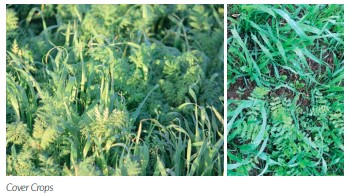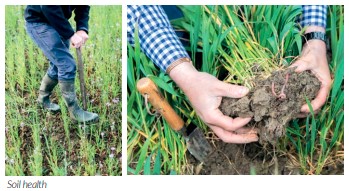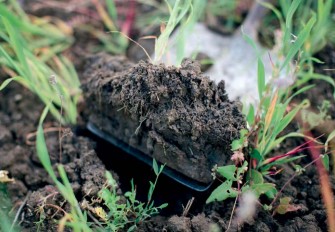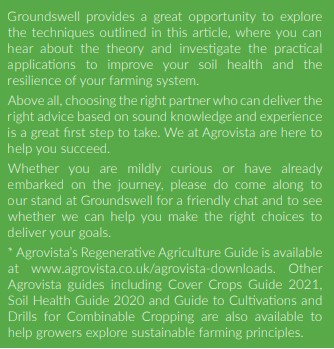CHRIS MARTIN FROM AGROVISTA

Industrial farming has been an incredible success story when it comes to increasing production. But many people, including me, believe this era is coming to an end. It is time to rethink the way we go about producing crops.
For the past few decades UK agriculture has become increasingly reliant on the can to control grass weeds, diseases and pests, and on heavy machinery to beat soil into submission to create seed-beds. We’ve been fighting mother nature for the past 70 years, and we now need to work with her. The silver bullets we once had to control all manner of ills are not coming along as often and, when they do, they tend to break down more quickly to resistance pressures.
The ongoing degradation of biodiversity and soil fertility we have experienced is making agriculture increasingly reliant on these synthetic inputs to prop up the system. It will get worse and, at some point, it will fail. Putting things right won’t happen overnight. We need to wean ourselves off this industrial approach and adopt a hybrid model that incorporates the best holistic methods backed up by effective chemistry. We need to switch from degenerative to regenerative approaches.
Done correctly, this will result in:
• Better soil health to help optimise crop health and yield
• Maintained or enhanced crop yields to underpin returns and drive down production costs
• Improved farm profitability through targeted inputs and reduced establishment costs
• Enhanced carbon sequestration to tackle climate change and offer potential new income streams.
Regenerative agriculture has shot to prominence over the past couple of years in the UK, but many people are unsure what it entails. I define it as a system of farming principles and practices that aims to reverse the errors created by previous unsustainable methods.

It works alongside nature to increase biodiversity, improve soils and protect the environment, while delivering benefits to humans through an improved natural environment and healthier ecosystems. The journey towards regenerative agriculture can appear very daunting. However, I cannot emphasise enough that it is not prescriptive – how far people want to go down the more sustainable farming route is a personal choice. It doesn’t have to be all or nothing; very useful effects can often be obtained from quite conservative tweaks, depending on the farm’s current practices, and the process can be undertaken at a pace that suits the individual.

Some people might opt for a complete reboot, reassessing their system and introducing wholesale change. For others, it may be as simple as dropping a pass with a power harrow, or amending the rotation. There are plenty of stops where you can get off along the way.
Full-blown regenerative agriculture is based on five key
principles:
1 Limiting physical and chemical disturbance of the soil
Reduced tillage can bring several advantages, including improved soil structure and stability, increased drainage and water-holding capacity and reduced risk of runoff and pollution of surface waters. It also results in significant savings in energy consumption and lower CO2 emissions.
Options will depend on a range of factors, including regional suitability, soil type and drainage, along with soil biology and chemistry, harvest residue management, resistant grass weeds and plant nutrition.
2 Keeping soil covered
Providing the soil with armour by employing cover and catch crops to maintain plant cover/residues at all times will protect the soil from adverse conditions, greatly reducing wind and water erosion and compaction, whilst preventing moisture evaporation and germination of weed seeds.
3 Keeping living roots in the soil
Ensuring living roots are always present will help improve soil structure and nutrient capture, while reducing soil erosion and building soil fertility and nutrition. Living plants are also essential for harvesting sunlight, our greatest resource.
4 Plant diversity
Increased diversity can be achieved by intercropping cash crops, improving crop rotations and using multi-species cover crops. Growing a range of plants across the farm helps to improve crop resilience and optimise yields over time. A good mix of species will build a healthy soil microbial population and improve soil biodiversity, supplying plants with the nutrients they need, which greatly reduces the need for synthetic fertilisers.
5 Integrating livestock
This practice benefits soil health, animal health and the environment. Grazing animals after annual crop harvests aids in the conversion of high-carbon residues to low-carbon organic manure. Grazing on cover crops can allow more nutrient cycling from crop to soil and carbon sequestration into your soils.
By adopting some or all of the above principles to varying degrees that best fit a farm’s individual circumstances, growers can start to improve the sustainability of their systems, building long-term soil health and functionality whilst maintaining farm yields and improving overall farm profitability. So where do we start? There are several things we need to ascertain before any decisions are made: what is the current soil heath status; what does the grower want to do; how can we enable that vision; how can we ensure progress remains on track?
“The journey towards regenerative agriculture is not prescriptive – how far people want to go is a personal choice”
• What is the current soil heath status?
We must first understand the relationship between a soil’s physical structure, its biology and the chemical processes within it. These are the keys to creating and maintaining healthy soils that are essential for crop and livestock production.
The whole process starts with a comprehensive soil test. If you don’t measure, you can’t manage. You have to know the starting point for the physical, biological and chemical properties of your soils.
• What does the grower want/need to do?
What is the main driver – is it long-term soil health, carbon capture, compliance with support schemes, or improving the legacy of the farm, for example? Where is the farmer in terms of the journey and where does he or she want to go? Most importantly, be realistic. Is the land capable of delivering those aims? And what about the bottom line? The financials are often overlooked. Throughout this process, the farm must still make money. Many people say you have to take a hit in the first few years – buy a direct drill and the benefits will come. I fundamentally disagree – if you are not making money, the process will eventually fail, and you are putting your business at unnecessary risk.

• How can we enable the vision?
We can now decide what action to take, by examining how various farming practices affect soils and what needs to be done to deliver the desired changes. Do we need to rethink the farm’s machinery policy? Is the current rotation suitable to achieve the goals we have set? Do we need to rethink the whole production system?
There is no black-and-white answer – any advice must be tailored to an individual farm’s needs, its ability to deliver, and the timeframe involved, based on the balance of probability of achieving the best outcome.
• How can we ensure progress remains on track?
We need to ensure we are using useful key performance indicators that are, above all, practical. Using definitive numbers may look and sound good, but they are often of limited use. The soil is a living, dynamic medium and I’ve yet to find a soil test that provides a definitive numerical figure that is both meaningful and fully repeatable. We need to be looking for trends to ensure we are going in the right direction, whether that be financial or physical. There is no blueprint for success. We need to bridge the gap between the science and practical farming, and a degree of flexibility will be key.
